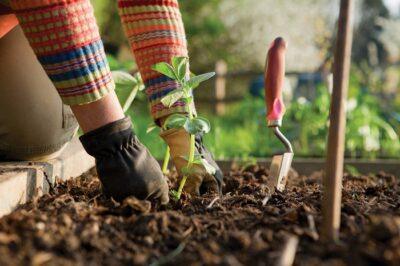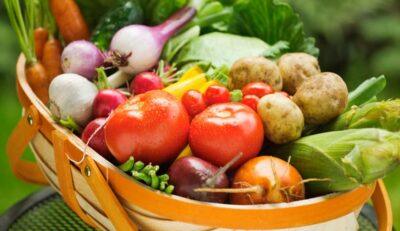For thousands of years, cultures around the world have sown, grown and harvested crops with nothing more than hard work and local resources. But in the 1950s, that began to change. New hybrid plants were introduced, along with synthetic fertilizers and powerful chemical pesticides. These developments disrupted the natural ecosystem of plant growth, and substituted it with a sterile, highly chemical-dependent system.
Despite these modern gardening practices, it’s possible to return to the past and have a sustainable garden. A sustainable garden is one that flourishes with nothing but input from the homestead.
Five key components are required: water, sunlight, amended soil, seeds and pest/disease control. We’ve already covered finding the perfect location for water and sunlight, so this article focuses on the remaining three components.
1. Amended Soil
Amended soil refers to soil that has been supplemented with nutrients to ensure healthy plant growth. The amount of amendments differs depending on several factors, including original nutrient content, history of plant growth, and concentration of plants.
For a sustainable garden, I recommend using the French intensive or square-foot gardening methods previously explained at Off The Grid News. The basic idea is that plants are spaced closely together and grown in rich soil. The benefits of this are less space but better output due to the richly composted material. Water use is also minimized, which is important on any homestead.
For every 100 square feet of garden, assume initially that two cubic feet of compost will be needed. This may not sound like a lot, but experienced gardeners know just how much raw material it takes to get two cubic feet of cured compost.
Order your 2015 Heirloom Solutions seed catalog and get $20 in your account!
There are many different ways to generate compost, but they generally fall into two categories: plant-based or animal-based. The best choice depends on the activities on your homestead. Here, we discuss three possible options.
Green Manure
Cover crops are grown in the garden before or after the food-producing crops have been grown. They protect the soil from erosion and add needed nutrients back into the soil for future plantings.
Green manure refers to cover crops that are grown in your garden and then tilled back into the soil, usually when they are still green. Often planted in the fall after harvesting the summer crops, the cover crop gets in some growth before winter. Depending on the type planted, the cover crop may die over winter, or it may become dormant and then come back to life in the spring.
For an area that will be used to grow summer crops, winter rye can be planted in the fall. In early spring, after it returns to life, it is then tilled (or dug manually) back into the soil. By the last frost date, the amended soil is ready for tomatoes, squash and other summer favorites.
For an area that will be used for spring crops, plant crops that die over the winter. One example is non-dormant wheat. When spring arrives and the soil is workable, the wheat can be tilled into the soil and the garden is ready for spring crops.
Compost Crops
A second option is to grow crops that are harvested and put into compost piles to naturally decompose. The advantage of these compost crops (often called carbon crops) is that often part of the plant can be used for food or fodder. Examples include sorghum, wheat or corn, the grains of which can ground for humans or fed to livestock whole. Once the grains are harvested, the remaining plants are composted, and then the cured compost is added to the garden.
Animal Compost
Animal manure from chickens, rabbits, cattle and other vegetarian animals can either replace or supplement compost crops. Animal manure must be cured like plant-based compost. Many homesteaders with plentiful manure simply layer it on top of the garden in the fall (after the summer crops are harvested) and let it cure over winter. By spring, the garden is ready to go.
2. Seeds
For a sustainable garden, seed-saving is a must — both for crops grown for human consumption, but also crops for fodder or compost.
Most of the seeds available through catalogs, and most seedlings from nurseries, are hybrids. Although hybrids often produce more abundant crops, and sometimes are more disease-resistant, you can’t use their seeds because the resulting plants will invariably be inferior.
New Natural Fertilizer Doubles Garden Production!
Therefore, you need to purchase heirloom, or open-pollinated, seeds to begin your garden. Heirloom vegetables are those that have been around for a long time — 50 years or so. Seeds from heirloom plants will yield fruit identical to the parent crop. Look for varietals that originate from the same climate as yours. For example, corn was grown by Native Americans throughout much of South and North America before Columbus came. So, if you live in the Northeast, try the cold-tolerant corn that the Iroquois grew in that area. Or if you have a homestead in the Southwest, try some of the drought-resistant varieties historically grown there.
3. Pest and Disease Control
Gardens grown organically, without synthetic fertilizers or harmful pesticides, usually have a healthy ecosystem in the soil. This healthy ecosystem is the greatest weapon against pests and diseases.
Even a healthy ecosystem, however, can fall prey to pests or disease. There are three additional practices that can help minimize loss of plants to pests or disease.
First, crop rotation is necessary. By planting crops in different locations each year, natural pests get confused when they show up at the same place next year and their favorite plant isn’t there.
Second, companion planting is an extremely effective tool. Different plants complement each other, improving growth and deterring pests. For example, radishes sprinkled throughout the squash patch deter squash bugs. Carrots Love Tomatoes, by Louise Riotte, is the classic book on this subject.
Finally, handpicking pests can be effective, too. For example, the harmful impact of hornworms on tomatoes can be controlled by simply removing them from the plants. Although the method is labor-intensive and not ideal, it’s a viable option in a small garden.
Conclusion
If you’re serious about becoming more self-sufficient, a self-sustaining garden is mandatory. However, it will take some time and practice to make it so. Give yourself three to five years to be able to reliably generate compost, save seeds, and learn which pest control techniques work best for you.
What are ways you keep your garden self-sustaining? Share your suggestions in the section below:
 Off The Grid News Better Ideas For Off The Grid Living
Off The Grid News Better Ideas For Off The Grid Living






